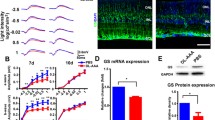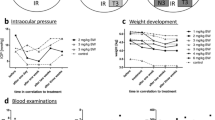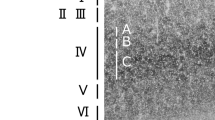Abstract
Background
In chronic liver disease the neuroglial cells may be affected by neurotoxic metabolites which, in turn, could be expected to affect neuronal functions. The aim of this study was to evaluate the electroretinograms (ERG) from patients before and after liver transplantation, in order to study possible functional changes of the retina.
Methods
Twelve patients with liver cirrhosis underwent routine ophthalmological examination and ERG before and after successful liver transplantation. Laboratory parameters, including ammonia, aspartate aminotransferase (AST), bilirubin, and cholinesterase, were compared. Patients were grouped according to the Child classification: three patients were Child A, six were Child B, three were Child C.
Results
Most obvious ERG abnormalities were found in patients with cirrhosis Child C. Before transplantation 7 of 21 ERG parameters were out of the normal range, but in the follow-up examination after transplantation only one parameter was not within the normal range. Significant (P<0.05) postoperative improvements were found for the latencies of scotopic, mesopic and photopic b-waves and mesopic a-waves and for the photopic implicit time. Patients in the Child B group revealed less changes in the ERG. Before the transplantation only one parameter of the ERG was out of the normal range. All postoperative parameters were within the normal range. At 40±9 months after the liver transplantation a significant decrease in serum ammonia levels, AST and bilirubin and a significant increase in cholinesterase levels were observed.
Conclusion
Patients with restored liver function after liver transplantation showed significantly improved ERG parameters. Our data suggest a recovery of the cells involved in hepatic retinopathy, including the Müller (glial) cells.



Similar content being viewed by others
References
Bringmann A, Reichenbach A (2001) Role of Müller cells in retinal degenerations. Front Biosci 6: E77–92
Bringmann A, Kuhrt H, Gerner A, Biedermann B, Reichenbach A (1998) Müller (glial) cell development in vivo and in retinal explant cultures: morphology and electrophysiology, and the effects of elevated ammonia. J Hirnforsch 39:193–206
Bringmann A, Kuhrt H, Germer A, Biedermann B, Reichenbach A (1998) Müller (glial) cell development in vivo and in retinal explant cultures: morphology and electrophysiology, and the effects of elevated ammonia. J Brain Res 39:193–206
Butterworth RF (1996) The neurobiology of hepatic encephalopathy. Semin Liver Dis 16:235–244
Delank H-W (1991) Enke, Stuttgart, p 282
Eckstein AK, Reichenbach A, Jacobi P, Weber P, Gregor M, Zrenner E (1997) Hepatic retinopathia. Changes in retinal function. Vision Res 37:1699–1706
Kashani AA (1999) Letters to the Editor: Hepatic retinopathy: changes in retinal function. Vision Res 39:2027–2029
Keeling PWN, O`Day J, Ruse W, Thompson RPH (1982) Zinc deficiency and photoreceptor dysfunction in chronic liver disease. Clin Sci 62:109–111
Kraft SP, Parker JA, Maruk Y, Rao AV (1987) The rat electroretinogram in combined zinc and vitamin A deficiency. Invest Ophthalmol Vis Sci 28:975–984
Lei B, Perlman I (1999) The contribution of voltage- and time-dependent potassium conductances to the electroretinogram in rabbits. Vis Neurosci 16:741–754
Linser PJ, Sorrentino M, Moscona AA (1984) Cellular compartmentalization of carbonic anhydrase-C and glutamine synthetase in developing and mature mouse neural retina. Dev Brain Res 13:65–71
Moschos M, Panagakis E, Palimeris G, Velissaropoulos P (1977) Alterations de l'ERG dans les metalloses experimentales. Arch Ophtalmol 37:285–294
Newman EA, Frishman LJ (1991) Mosby, St. Louis, pp101–111
Newman EA, Reichenbach A (1996) The Müller cell: a functional element of the retina. Trends Neurosci 19:307–312
Newman NJ, Capone A, Leeper HF, O`Day DG, Mandell B, Lambert SR, Thoft RA (1994) Clinical and subclinical ophthalmic findings with retinol deficiency. Ophthalmology 101:1077–1083
Norenberg MD (1996) Astrocytic-ammonia interactions in hepatic encephalopathy. Semin Liver Dis 16:245–253
Norenberg MD, Baker L, Norenberg L-OB, Blicharska J, Bruce-Greogorios JH, Neary JT (1991) Ammonia-induced astrocyte swelling in primary culture. Neurochem Res 16:833–836
O'Neill DP (1992) The eye and liver disorders. Eye 6:366–370
Poitry-Yamate CL, Poitry S, Tsacopoulos M (1995) Lactate released by Muller glial cells is metabolized by photoreceptors from mammalian retina. J Neurosci 15:5179–5191
Pow DV, Crook DK (1996) Direct immunocytochemical evidence for the transfer from glial cells to neurons: use of specific antibodies directed against the D-stereoisomers of glutamte and glutamine. Neuroscience 70:295–302
Pow DV, Robinson SR (1994) Glutamate in some retinal neurons is derived solely from glia. Neuroscience 60:355–366
Reichenbach A (1999) Neuroglia – Das andere zelluläre Element im Nervensystem: Die Müllersche Gliazelle. SMV Edition Materia Medica, p 70
Reichenbach A, Stolzenburg JU, Eberhardt W, Chao TI, Dettmer D, Hertz L (1993) What do retinal Müller (glial) cells do for their neuronal "small siblings". J Chem Neuroanat 6:201–213
Reichenbach A, Stolzenburg JU, wolburg H, Härtig W, El-Hifnawi E, Martin H (1995) Effects of enhanced extracellular ammonia concentration on cultured mammalian retinal glial (Müller) cells. Glia 13:195–208
Reichenbach A, Fuchs U, Kasper M, El-Hifnawi E, Eckstein AK (1995) Hepatic retinopathy: morphological features of retinal glial (Müller) cells accompanying hepatic failure. Acta Neuropathol 90:273–281
Scholl HP, Zrenner E (2000) Electrophysiology in the investigation of acquired retinal disorders. Surv Ophthalmol 45:29–47
Shiells RA, Falk G (1999) Contribution of rod, on-bipolar, and horizontal cell light responses to the ERG of dogfish retina. Vis Neurosci 16: 503–511
Tian N, Slaughter MM (1995) Correlation of dynamic responses in the ON bipolar neuron and the b-wave of the electroretinogram. Vision Res 35:1359–1364
Wen R, Oakley B (1990) K+-evoked Müller cell depolarization generates b-wave of electroretinogram in toad retina. Proc Natl Acad Sci 87:2117–2121
Acknowledgements
We thank Mrs. Wojan for her excellent assistance and help in performing the ERG. Part of this work was supported by the Bundesministerium für Bildung, Forschung und Technologie (BMB+F), Interdisciplinary Center for Clinical Research at the University of Leipzig (01KS9504, Project C5).
Author information
Authors and Affiliations
Corresponding author
Rights and permissions
About this article
Cite this article
Uhlmann, S., Uhlmann, D., Hauss, J. et al. Recovery from hepatic retinopathy after liver transplantation. Graefe's Arch Clin Exp Ophthalmol 241, 451–457 (2003). https://doi.org/10.1007/s00417-003-0639-3
Received:
Revised:
Accepted:
Published:
Issue Date:
DOI: https://doi.org/10.1007/s00417-003-0639-3




